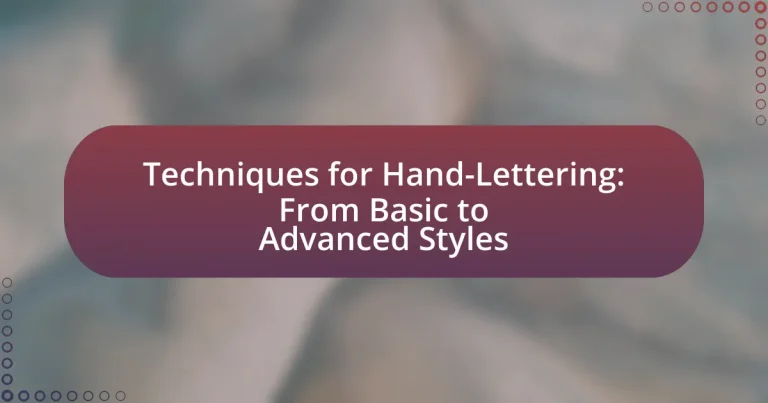The article focuses on the fundamental techniques of hand-lettering, detailing the processes of sketching, inking, and refining letterforms. It emphasizes the importance of basic strokes, essential tools for beginners, and the impact of paper choice on the lettering process. Additionally, it explores various hand-lettering styles, the distinction between serif and sans-serif fonts, and the progression from basic to advanced techniques. The article also highlights best practices for mastering hand-lettering, the significance of feedback, and available resources for aspiring artists, providing a comprehensive guide for those looking to enhance their skills in this art form.

What are the fundamental techniques of hand-lettering?
The fundamental techniques of hand-lettering include sketching, inking, and refining. Sketching serves as the initial phase where artists draft letterforms using pencil, allowing for adjustments and creativity. Inking follows, where artists apply ink to finalize the letterforms, often using various tools like brushes or pens to achieve different styles. Refining is the final step, involving the addition of details, shading, and embellishments to enhance the overall appearance. These techniques are essential for creating visually appealing hand-lettered designs, as they allow for both precision and artistic expression.
How do basic strokes influence hand-lettering styles?
Basic strokes are fundamental elements that significantly influence hand-lettering styles by serving as the building blocks for letterforms. Each hand-lettering style, whether serif, sans-serif, or script, derives its unique characteristics from variations in these strokes, such as thickness, angle, and curvature. For instance, a calligraphic style often emphasizes fluid, sweeping strokes, while a modern sans-serif style may utilize straight, uniform strokes. The manipulation of these basic strokes allows artists to create distinct visual identities and convey different emotions or themes in their lettering. This foundational role of basic strokes is evident in the way they dictate the overall aesthetic and readability of the final piece, making them essential to the art of hand-lettering.
What are the essential strokes every hand-letterer should master?
The essential strokes every hand-letterer should master include the upstroke, downstroke, entrance stroke, exit stroke, and oval stroke. These foundational strokes form the basis of letterforms and are critical for developing consistent and fluid handwriting styles. Mastery of these strokes allows hand-letterers to create a variety of letter styles and improve their overall technique, as each stroke contributes to the structure and flow of letters.
How do different stroke techniques affect letterforms?
Different stroke techniques significantly influence the appearance and characteristics of letterforms. For instance, varying pressure during strokes can create contrast between thick and thin lines, which enhances the visual interest and legibility of the letters. Techniques such as calligraphy, where strokes are executed with a specific angle and pressure, result in elegant, flowing letterforms, while more rigid techniques, like block lettering, produce uniform shapes that convey a sense of stability. Historical evidence shows that the evolution of typography has been shaped by these stroke techniques, as seen in the transition from Gothic scripts to modern sans-serif fonts, where the latter often employs simpler, more consistent strokes for clarity and readability.
What tools are necessary for beginners in hand-lettering?
Beginners in hand-lettering need a few essential tools to get started effectively. These tools include quality paper, a pencil for sketching, erasers for corrections, and a variety of pens or markers, such as brush pens and fine liners, to create different styles and effects. Quality paper prevents ink bleed and allows for smooth writing, while pencils and erasers enable practice and adjustments. Brush pens offer flexibility in line thickness, and fine liners provide precision for detailed work. These tools are foundational for developing hand-lettering skills and techniques.
Which types of pens and brushes are best for hand-lettering?
The best types of pens and brushes for hand-lettering include brush pens, fountain pens, gel pens, and calligraphy brushes. Brush pens, such as the Tombow Fudenosuke, offer flexibility and control for varying line thickness, making them ideal for expressive lettering. Fountain pens, like the Lamy Safari, provide smooth ink flow and precision, suitable for detailed work. Gel pens, particularly those with a fine tip, allow for vibrant colors and smooth application, enhancing the visual appeal of hand-lettering. Calligraphy brushes, such as those made from sable or synthetic fibers, enable traditional techniques and fluid strokes, essential for classic styles. These tools are widely recommended by artists and educators for their effectiveness in achieving high-quality hand-lettering results.
How does paper choice impact the hand-lettering process?
Paper choice significantly impacts the hand-lettering process by influencing the texture, absorbency, and weight of the medium used. Different types of paper, such as smooth, textured, or watercolor paper, affect how ink or pencil interacts with the surface, which can alter the final appearance of the lettering. For instance, smooth paper allows for cleaner lines and finer details, while textured paper can create a more organic look but may cause ink to bleed or feather. Additionally, absorbent papers can soak up ink quickly, leading to less control over the flow, while heavier papers can support various mediums without warping. These characteristics are crucial for achieving desired effects in hand-lettering, as they dictate the ease of application and the overall quality of the finished work.
What are the common styles of basic hand-lettering?
Common styles of basic hand-lettering include serif, sans-serif, script, and decorative lettering. Serif lettering features small lines or embellishments at the ends of strokes, providing a classic and formal appearance. Sans-serif lettering lacks these embellishments, resulting in a clean and modern look. Script lettering mimics cursive handwriting, often characterized by fluid and connected letters, conveying elegance and personality. Decorative lettering incorporates unique artistic elements, allowing for creativity and individual expression. Each style serves different purposes and can be adapted for various projects, making them foundational in hand-lettering techniques.
What distinguishes serif from sans-serif lettering styles?
Serif lettering styles are characterized by small lines or decorative strokes at the ends of their letters, known as “serifs,” while sans-serif lettering styles lack these embellishments. The presence of serifs in serif fonts is believed to enhance readability in printed text, as evidenced by studies showing that serif fonts can improve reading speed and comprehension in long passages. In contrast, sans-serif fonts are often considered more modern and are frequently used in digital formats due to their clean and straightforward appearance, which can be easier to read on screens.
How can one achieve consistency in letter height and spacing?
To achieve consistency in letter height and spacing, one should use a grid or guidelines as a reference. This method allows for uniformity in the size and placement of letters, ensuring that each character aligns properly with others. Utilizing tools such as a ruler or a template can further enhance precision, as they provide a physical structure to follow. Studies in typography indicate that consistent letter height and spacing improve readability and aesthetic appeal, reinforcing the importance of these techniques in hand-lettering practices.

How can one progress from basic to advanced hand-lettering techniques?
To progress from basic to advanced hand-lettering techniques, one should practice consistently, study various styles, and experiment with different tools. Consistent practice helps in developing muscle memory and refining skills, while studying various styles exposes the individual to diverse techniques and inspirations. Experimenting with different tools, such as brushes, pens, and papers, allows for the discovery of unique effects and personal style. Additionally, resources like online tutorials and workshops can provide structured learning and feedback, further enhancing skill development.
What are the key differences between basic and advanced styles?
Basic styles in hand-lettering are characterized by simplicity and uniformity, focusing on fundamental shapes and consistent letterforms. In contrast, advanced styles incorporate intricate designs, varied line weights, and embellishments, allowing for greater creativity and personalization. The distinction lies in the complexity and artistic expression; basic styles serve as foundational techniques, while advanced styles build upon these principles to create more dynamic and visually engaging lettering.
How do advanced techniques enhance the visual appeal of lettering?
Advanced techniques enhance the visual appeal of lettering by introducing complexity and depth through methods such as layering, shading, and the use of varied typography. These techniques allow artists to create more dynamic and engaging designs that capture attention. For instance, layering different colors or textures can add dimension, while shading can create a three-dimensional effect, making the letters appear more lifelike. Additionally, varied typography can evoke different emotions and styles, further enhancing the overall aesthetic. Research indicates that visual complexity in design can significantly increase viewer engagement, as seen in studies on graphic design effectiveness.
What role does creativity play in developing advanced styles?
Creativity is essential in developing advanced styles in hand-lettering as it allows artists to innovate and personalize their work. By experimenting with different forms, shapes, and techniques, creators can push the boundaries of traditional lettering, resulting in unique styles that reflect individual expression. For instance, studies in design psychology indicate that creative exploration leads to greater originality, which is crucial in distinguishing advanced styles from basic ones. This innovative approach not only enhances aesthetic appeal but also engages viewers, making the artwork more impactful.
What are some popular advanced hand-lettering styles?
Some popular advanced hand-lettering styles include modern calligraphy, brush lettering, and vintage typography. Modern calligraphy combines traditional techniques with contemporary flair, often featuring fluid strokes and varying line thickness. Brush lettering utilizes a brush pen to create expressive, sweeping letters, emphasizing the contrast between thick and thin lines. Vintage typography draws inspiration from historical lettering styles, incorporating ornate details and decorative elements. These styles are widely recognized in the hand-lettering community for their unique aesthetics and versatility in design applications.
How can one incorporate modern calligraphy into their work?
One can incorporate modern calligraphy into their work by integrating it into various design projects such as invitations, branding, and personal stationery. This technique enhances visual appeal and adds a personalized touch, making the work stand out. For instance, using modern calligraphy for wedding invitations can create an elegant and sophisticated look, as evidenced by the growing trend in the wedding industry where 70% of couples opt for custom calligraphy to reflect their unique style. Additionally, incorporating modern calligraphy into social media graphics can increase engagement, as visually appealing content is known to perform better, with studies showing that posts with handwritten elements receive 30% more likes.
What techniques are used in brush lettering for advanced styles?
Advanced brush lettering techniques include pressure variation, layering, and blending. Pressure variation involves applying different amounts of pressure on the brush to create thick and thin strokes, which adds depth and dimension to the lettering. Layering refers to the technique of building up colors or shades by applying multiple layers of paint or ink, enhancing the visual complexity of the letters. Blending, on the other hand, is the process of smoothly transitioning between colors, often achieved by mixing them on the paper or using a wet brush to create gradients. These techniques are essential for achieving intricate and visually appealing brush lettering styles.

What are the best practices for mastering hand-lettering?
To master hand-lettering, consistent practice, understanding letter anatomy, and experimenting with various styles are essential. Regular practice helps develop muscle memory and improves control over tools, while studying letter anatomy enhances the ability to create balanced and visually appealing letters. Additionally, experimenting with different styles fosters creativity and allows for personal expression. Research indicates that artists who engage in deliberate practice, focusing on specific skills, show significant improvement over time, reinforcing the importance of these best practices in mastering hand-lettering.
How can one effectively practice hand-lettering techniques?
To effectively practice hand-lettering techniques, one should consistently engage in structured exercises that focus on letterforms, spacing, and style variations. Regularly practicing basic strokes and shapes builds foundational skills, while experimenting with different styles enhances versatility. Research indicates that dedicating at least 30 minutes daily to focused practice can significantly improve hand-lettering proficiency, as consistent repetition reinforces muscle memory and technique.
What exercises can improve hand-lettering skills?
Practicing specific exercises can significantly improve hand-lettering skills. One effective exercise is to repeatedly write the alphabet in both uppercase and lowercase, focusing on consistency in size and spacing. Another beneficial exercise involves creating a series of strokes, such as loops, lines, and curves, to develop muscle memory and control. Additionally, copying the work of skilled hand-letterers can help in understanding different styles and techniques. Research indicates that consistent practice of these exercises enhances fine motor skills and visual perception, which are crucial for hand-lettering proficiency.
How important is feedback in the learning process of hand-lettering?
Feedback is crucial in the learning process of hand-lettering as it helps individuals identify strengths and areas for improvement. Constructive feedback allows learners to refine their techniques, enhance their skills, and develop a personal style. Research indicates that feedback significantly boosts skill acquisition and retention, as it provides specific guidance that learners can apply to their practice. For instance, a study published in the Journal of Educational Psychology found that timely and specific feedback can lead to a 20% increase in performance in skill-based tasks, including artistic endeavors like hand-lettering.
What resources are available for aspiring hand-letterers?
Aspiring hand-letterers can access a variety of resources, including online courses, instructional books, and community workshops. Online platforms like Skillshare and Udemy offer courses that cover techniques from basic to advanced styles, allowing learners to progress at their own pace. Books such as “The Art of Hand Lettering” by Kelly Klapstein provide step-by-step guidance and exercises. Additionally, local art studios and community centers often host workshops that facilitate hands-on learning and networking with other artists. These resources collectively support the development of hand-lettering skills through structured learning and practical application.
Which online platforms offer tutorials and courses on hand-lettering?
Skillshare, Udemy, and CreativeLive are prominent online platforms that offer tutorials and courses on hand-lettering. Skillshare features a variety of classes ranging from beginner to advanced levels, taught by experienced artists. Udemy provides a wide selection of courses that cover different styles and techniques in hand-lettering, often with lifetime access to materials. CreativeLive offers live and recorded classes focusing on both the artistic and technical aspects of hand-lettering, led by industry professionals. These platforms collectively provide comprehensive resources for learners interested in developing their hand-lettering skills.
How can community engagement enhance hand-lettering skills?
Community engagement can enhance hand-lettering skills by providing opportunities for collaboration, feedback, and exposure to diverse styles. Engaging with a community allows hand-lettering enthusiasts to share techniques, receive constructive criticism, and learn from others’ experiences. For instance, participating in workshops or online forums can lead to skill improvement through peer support and shared resources. Research indicates that collaborative learning environments significantly boost creative skills, as individuals are inspired by the varied approaches and techniques of their peers.
What tips can help avoid common mistakes in hand-lettering?
To avoid common mistakes in hand-lettering, practice consistently and focus on proper letter spacing. Consistent practice helps develop muscle memory, which is crucial for achieving uniformity in letterforms. Proper letter spacing ensures that each character is distinct and legible, preventing overcrowding that can lead to confusion. Additionally, using guidelines can help maintain straight lines and consistent heights, further enhancing the overall appearance of the lettering. These techniques are widely recognized among artists and calligraphers as essential for improving hand-lettering skills.





